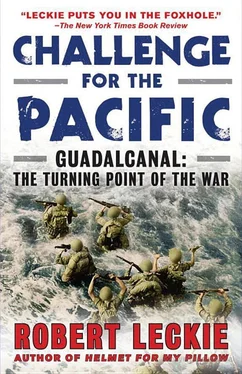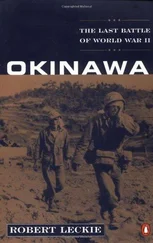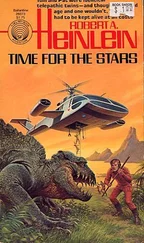2. Fuchida, Capt. Mitsuo, and Okumiya, Masatake, Midway: The Battle That Doomed Japan (Annapolis: United States Naval Institute, 1955), p. 48. (Imperial General Headquarters was composed of two sections or divisions. The Navy Section was presided over by the Chief of the Navy General Staff and the Army Section by the Chief of the Army General Staff. These two sections “consulted” on strategy, operations, and allocation of forces. After an agreement was reached, a “Central Agreement” was drawn up and signed by the section Chiefs. Each Chief issued orders to his subordinates and they, in turn, were to consult each other at the lower, implementing level. Thus, the Japanese military operated on the basis of “cooperation” rather than on the American basis of “control” or “unity of command,” and this, as will be seen, was not always conducive to clarity.)
3. Ibid , p. 11.
4. Clear, Lt. Col. Warren J., Close-up of a Jap Fighting Man (Infantry Journal , November 1942), p. 16.
5. Sakai, Saburo, with Caidin, Martin, and Saito, Fred, Samurai: Flying the Zero in WW II with Japan’s Fighter Ace (New York: Ballantine Books, 1963), p. 72.
6. Feldt, Cmdr. Eric A., R.A.N., The Coastwatchers (New York and Melbourne: Oxford University Press, 1946), p. 78.
7. Clemens, Martin, A Coastwatcher’s Diary (Unpublished manuscript on file at Research & Records [R&R], Historical Branch, G-3, Headquarters, U.S. Marine Corps), p. 4. (In this passage, and all other quotations in pidgin English, I have taken the liberty of altering Clemens’s faithful presentation of that lingua franca as it is spoken by the Solomon Islanders to what I believe may be a more readable form of pidgin.)
8. Halsey, Fleet Adm. William F., and Bryan, Lt. Cmdr. J., III, Admiral Halsey’s Story (New York: McGraw-Hill Book Co., 1947), p. 101.
9. Vandegrift, General Alexander A., and Asprey, Robert B., Once a Marine: The Memoirs of General A. A. Vandegrift (New York: Norton, 1964), p. 61.
10. Pierce, Lt. Col. P. N., The Unsolved Mystery of Pete Ellis (Marine Corps Gazette , February 1962), pp. 34, 40.
11. Smith, General Holland M., Coral and Brass: Howlin’ Mad Smith’s Own Story of the Marines in the Pacific (New York: Scribner’s, 1949), p. 177; and Davis, Burke, Marine!: The Life of Chesty Puller (Boston: Little, Brown, 1962), pp. 71, 72.
12. Davis, op. cit. , pp. 71, 72.
13. Vandegrift and Asprey, op. cit. , p. 25.
14. Author’s recollection.
15. Ibid .
1. Ito, Masanori, The End of the Imperial Japanese Navy (New York: Norton, 1956), p. 18.
2. Ibid , p. 19.
3. Ibid , p. 36.
4. Fuchida and Okumiya, op. cit. , p. 57.
5. Ibid , p. 60.
6. Vandegrift and Asprey, op. cit. , p. 100.
7. Halsey and Bryan, op. cit. , p. 103.
8. Fuchida and Okumiya, op. cit. , p. 71.
1. Clemens, op. cit. , p. 17.
2. Ibid , p. 34.
3. Hara, Cmdr. Tameichi, with Saito, Fred, and Pineau, Roger, Japanese Destroyer Captain (New York: Ballantine Books, 1961), p. 97.
4. Ibid .
5. Ibid , p. 99.
6. Morison, Samuel Eliot, Coral Sea, Midway and Submarine Action , Vol. IV. “History of the United States Navy in the Second World War” (Boston: Little, Brown, 1960), p. 98.
7. Clemens, op. cit. , p. 43.
8. Ibid , p. 50.
9. Butterfield, Roger, Al Schmid: Marine (New York: Farrar & Rinehart, 1944), p. 57.
10. Ibid , p. 58.
11. Vandegrift and Asprey, op. cit. , p. 102.
12. Ibid , p. 105.
13. Ibid , p. 111.
1. Clemens, op. cit. , p. 52.
2. Fuchida and Okumiya, op. cit. , p. 75.
3. Ohmae, Capt. Toshikazu, The Battle of Savo Island (United States Naval Institute Proceedings, December 1957), p. 1264.
4. Ibid , p. 1266.
5. Newcomb, Richard, Savo: The Incredible Naval Debacle off Guadalcanal (New York: Holt, Rinehart & Winston, 1961), p. 53.
6. Ibid , p. 53.
7. Vandegrift and Asprey, op. cit. , p. 46.
8. Author’s recollection.
9. Butterfield, op. cit. , pp. 64, 65.
10. Griffith, Brig. Gen. Samuel B., II, The Battle for Guadalcanal (Philadelphia and New York: Lippincott, 1963), p. 35.
11. Vandegrift and Asprey, op. cit. , p. 120.
12. Ibid , p. 120.
13. Ibid .
14. Griffith, op. cit. , p. 35.
15. Author’s recollection.
1. Shigemitsu, Premier Mamoru, Japan and Her Destiny (New York: Grosset & Dunlap, 1950), p. 271.
2. Intelligence Summary No. 22, Headquarters, U.S. Army Air Force, Southwest Pacific Area; History of 28th Bombardment Squadron (19th Bombardment Group) , 8 Dec. 1941–1 Feb. 1943, p. 16.
3. Clemens, op. cit. , p. 124.
4. Author’s recollection.
5. Vandegrift and Asprey, op. cit. , p. 19.
6. Leckie, Robert, Strong Men Armed (New York: Random House, 1962), p. 18.
7. Clemens, op. cit. , p. 125.
8. Japanese Eighth Fleet War Diary, Office of Naval Records and Library (ONRL), Document No. 161259, p. 6; Newcomb, op. cit. , p. 23.
1. Griffith, op. cit. , p. 46. (General Griffith, then a lieutenant colonel, was Edson’s executive officer.)
2. Newcomb, op. cit. , p. 23.
3. Sakai et al., op. cit. , p. 146.
4. Ibid , p. 147.
5. Griffith, op. cit. , p. 44.
6. Hara, op. cit. , p. 104.
7. Ibid , p. 104.
8. Tregaskis, Richard, Guadalcanal Diary (New York: Popular Library, 1959), p. 77.
9. Leckie, op. cit. , p. 23.
10. Sakai et al., op. cit. , p. 156.
11. Griffith, op. cit. , p. 47.
1. Author’s recollection.
2. Griffith, op. cit. , p. 42.
3. Ohmae, op. cit. , p. 1272.
4. Newcomb, op. cit. , p. 92.
5. Ohmae, op. cit. , p. 1273. (Note: All subsequent Japanese battle orders quoted at Savo are from the same source.)
6. Vandegrift and Asprey, op. cit. , p. 130.
7. Ibid .
1. Roscoe, Theodore, United States Destroyer Operations in World War II (Annapolis: United States Naval Institute, 1953), p. 153.
2. All these and similar quotations are from monitored Japanese broadcasts on file in the National Archives, Washington, D.C.
3. Letter, Commanding General, South Pacific, to Chief of Staff, U.S. Army, August 11, 1942. OPD 381, PTO1. World War II Archives, Alexandria, Va.
4. Letter, Commanding General, South Pacific, to Chief of Staff, U.S. Army, August 11, 1942. OPD 381, PTO1. World War II Archives, Alexandria, Va.
5. The Americans had a biblical precedent for this ruse. In a dispute with the men of Ephraim, the Israelite leader Jephte set guards at the fords of the Jordan with orders to ask each passerby if he were an Ephraimite. Each man who said “No” was asked to pronounce “shibboleth,” the word for an ear of corn or a flood or stream. Inasmuch as the Ephraimites could not make the sound “sh” they always answered “sibboleth,” thus betraying their identity. That is how the word shibboleth came first to mean a password, then a party slogan, and, finally, the sham or hackneyed rallying cry of some fashionable or partisan cause.
Читать дальше












